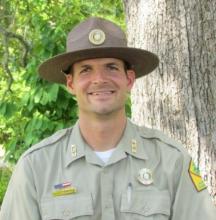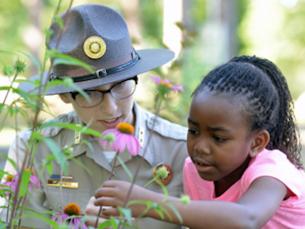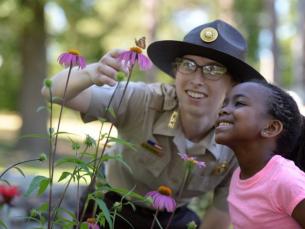Photo Essay: A Closer Look
By: Zachary FisherWith the warmer weather finally settling into the Ozark region of north-central Arkansas, it is exciting to think about getting outdoors again to enjoy some recreational activities in our public lands. Arkansas State Parks exist, in part, to enhance the quality of life through exceptional outdoor experiences and help our guests form personal connections to the parks and their resources.
Bull Shoals-White River State Park has a variety of walking paths and hiking trails of varying lengths and difficulties for visitors to explore, offering cliff top views overlooking the White River and shoreline stopping points along Bull Shoals Lake. Each trail and point of interest contribute to our park’s unique story.
While we often anticipate hiking towards a specific destination on the trail—perhaps a clearing with a view or a streamside bench for a picnic spot—we have a tendency to overlook the subtle, simple wonders occurring along the way, forgetting to “stop and smell the roses,” so to speak. Some of nature’s truly incredible “wow” moments are happening all over the forest floor, camouflaged against the shrubs and trees, or tucked beside a rotting log, and each of those has a story to uncover.
The following photos and descriptions provide a brief glimpse of a much grander narrative that is unfolding in nature all the time, regardless if we are witness to its mysteries. How many of these, and similar amazing things, can you spot during your next venture down a trail?
“It is a shame to miss that which is right beneath the steps of inquiring minds.” –Anonymous
Like something out of a Hobbit film, trees with large growths, or burls, are quite eye-catching, but what exactly is that bulbous lump? Not much is known about burls or what causes them, but it is generally agreed that trees with them have encountered a type of stressor, such as environmental damage, insect invasion, or the spread of a fungus. Most trees with burls can continue to grow unharmed as long as the outside layer of bark remains intact. Try to spot one of these trees as you walk the Heritage and Habitat Trail or hike along the Big Bluff Trail in our park.
At first glance, you might think that devil's urn is a collection of hollowed out acorns or maybe even a pile of decaying scat. However, this unique mushroom is commonly found during the spring in the eastern half of the United States, often decomposing downed hardwood trees. As this fungus grows in the warm spring weather, the opening becomes wider and the texture takes on a leathery feel. Because of its dark brown to blackish color, it can be tough to find, as it blends in well with the forest floor.
The unmistakable warty projections covering the bark of this sugarberry tree help to identify it in the elm family. Its berry-like fruit emerges later in the year, and is eaten by a variety of birds, including woodpeckers, robins, and cedar waxwings, as well as white-tailed deer. In addition, many American Indian cultures have used the berries, leaves, and bark for food and medicine.
At around a half inch long, this white-jawed jumping spider is easy to miss as it traverses a decaying tree trunk. When hiking, be sure to slow down and scan surfaces with your eyes if you are exploring for small wonders! Jumping spiders are part of the family Salticidae, and with over 6000 species, they make up the largest family of spiders. Known for their excellent eyesight, they are also talented jumpers, especially when hunting or reacting to threats.
This small tree has most likely sustained some type of injury or deformity and is recovering, but now an entire miniature ecosystem exists inside the tree hole. As water and decaying matter collect, it forms a perfect environment for bacteria, protozoa (single-celled organisms), and even mosquito larvae, all battling for survival on a microscopic level. Look for this tree along the beginning section of the Big Bluff Trail in our park.
It is common to see moss growing in moist, shady areas all over Arkansas, but did you know that there are approximately 12,000 species of this flowerless plant? Mosses also lack a proper root system, but that does not stop them from providing an excellent habitat for insects, spiders, and worms. Furthermore, they serve as a “bioindicator” – signaling when air quality is healthy or poor.
You should always use caution around plants you are unfamiliar with, especially if you suspect them to be potentially harmful. Even though this picture shows young leaves of Virginia creeper, a climbing vine common throughout the state, it is sometimes confused with poison ivy. It is important to learn to recognize what poison ivy looks like and how to protect yourself from the allergic reaction it can cause.
Earthworms are often overlooked, but they have an incredible part in maintaining a balanced ecosystem in the habitats of this park. As they burrow through the ground, the small tunnels they create help aerate the ground and keep moisture from rain dispersed, while contributing nutrients back into the soil. Additionally, they are a key source of nourishment within the food chain for many birds, reptiles, amphibians, fish, and mammals.
Tucked under the roots of an old tree along the Lakeside Trail is an unassuming hollowed out area that could be an animal’s actively used shelter, an abandoned den, or the entrance to a series of tunnels for a quick escape. Smaller mammals, such as least shrews, eastern moles, white-footed mice, and woodland voles, sometimes utilize openings around the base of trees for creating nests or evading predators. Larger mammals, like eastern chipmunks, long-tailed weasels, opossums, and eastern cottontails, may also burrow underneath exposed tree stumps and use the space to raise their young.
Line by line, landscape’s narrative develops – cyclical, but not entirely predictable; random, but most assuredly connected; seemingly chaotic, but not without purpose. Hopefully, by highlighting a few of the small and sometimes unnoticed details happening in nature, it has ignited in you a desire to discover more of this untold story.
What will catch your attention? You can capture these moments by documenting them in a personal journal or drawing in a sketchpad. If you want to share with others, consider taking a picture and posting on social media, and be sure to tag #ARStateParks and mention what park you explored.
Now is the time to get outside and uncover the story!




